2008 INFINITI QX56 warning
[x] Cancel search: warningPage 3944 of 4083
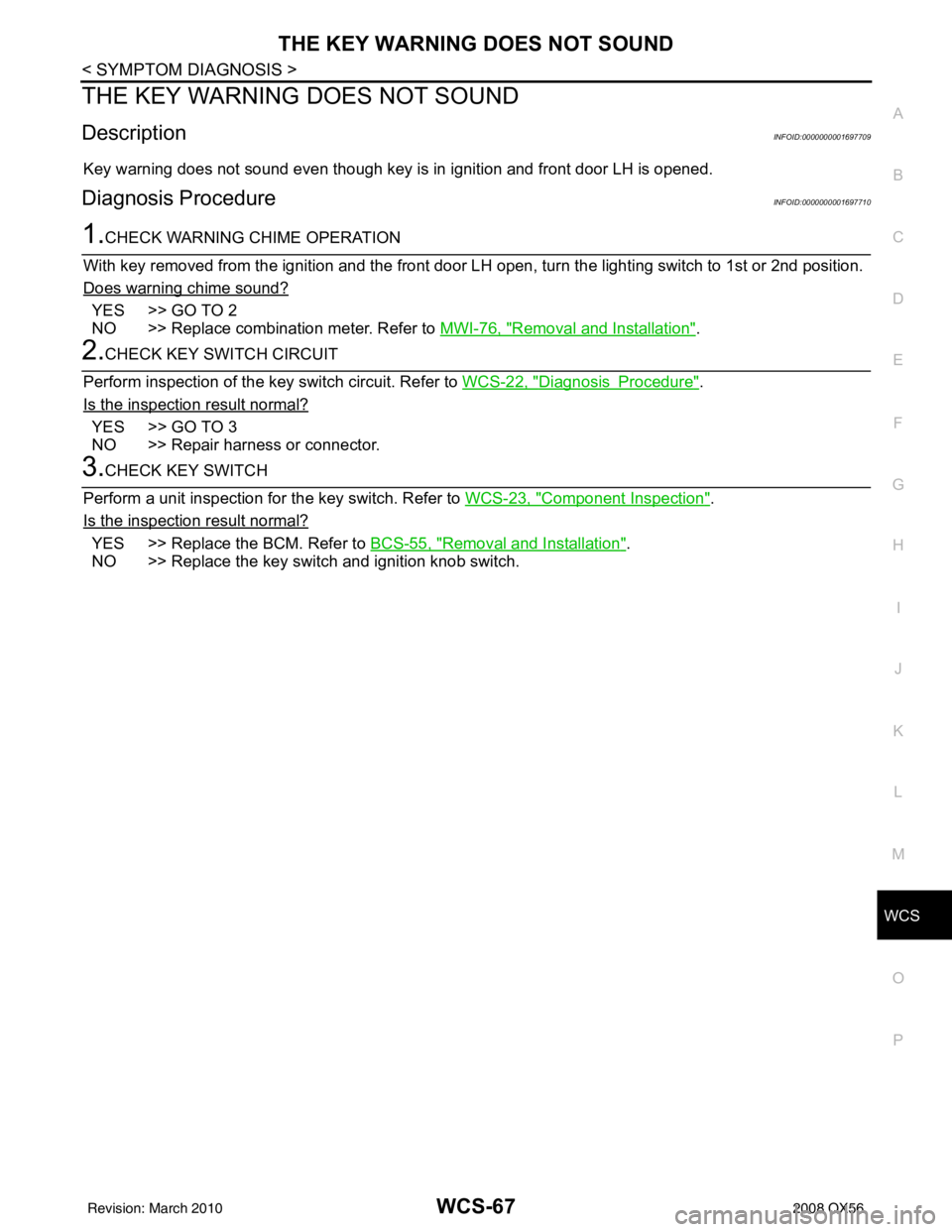
WCS
THE KEY WARNING DOES NOT SOUNDWCS-67
< SYMPTOM DIAGNOSIS >
C
DE
F
G H
I
J
K L
M B A
O P
THE KEY WARNING DOES NOT SOUND
DescriptionINFOID:0000000001697709
Key warning does not sound even though key is in ignition and front door LH is opened.
Diagnosis ProcedureINFOID:0000000001697710
1.CHECK WARNING CHIME OPERATION
With key removed from the ignition and the front door LH open, turn the lighting switch to 1st or 2nd position.
Does warning chime sound?
YES >> GO TO 2
NO >> Replace combination meter. Refer to MWI-76, "
Removal and Installation".
2.CHECK KEY SWITCH CIRCUIT
Perform inspection of the key switch circuit. Refer to WCS-22, "
DiagnosisProcedure".
Is the inspection result normal?
YES >> GO TO 3
NO >> Repair harness or connector.
3.CHECK KEY SWITCH
Perform a unit inspection for the key switch. Refer to WCS-23, "
Component Inspection".
Is the inspection result normal?
YES >> Replace the BCM. Refer to BCS-55, "Removal and Installation".
NO >> Replace the key switch and ignition knob switch.
Revision: March 2010 2008 QX56
Page 3945 of 4083

WCS-68
< PRECAUTION >
PRECAUTIONS
PRECAUTION
PRECAUTIONS
Precaution for Supplemental Restraint System (SRS) "AIR BAG" and "SEAT BELT
PRE-TENSIONER"
INFOID:0000000004857542
The Supplemental Restraint System such as “A IR BAG” and “SEAT BELT PRE-TENSIONER”, used along
with a front seat belt, helps to reduce the risk or severity of injury to the driver and front passenger for certain
types of collision. This system includes seat belt switch inputs and dual stage front air bag modules. The SRS
system uses the seat belt switches to determine the front air bag deployment, and may only deploy one front
air bag, depending on the severity of a collision and w hether the front occupants are belted or unbelted.
Information necessary to service the system safely is included in the SR and SB section of this Service Man-
ual.
WARNING:
• To avoid rendering the SRS inopera tive, which could increase the risk of personal injury or death in
the event of a collision which would result in air bag inflation, all maintenance must be performed by
an authorized NISSAN/INFINITI dealer.
• Improper maintenance, including in correct removal and installation of the SRS, can lead to personal
injury caused by unintent ional activation of the system. For re moval of Spiral Cable and Air Bag
Module, see the SR section.
• Do not use electrical test equipmen t on any circuit related to the SRS unless instructed to in this
Service Manual. SRS wiring harn esses can be identified by yellow and/or orange harnesses or har-
ness connectors.
PRECAUTIONS WHEN USING POWER TOOLS (AIR OR ELECTRIC) AND HAMMERS
WARNING:
• When working near the Airbag Diagnosis Sensor Unit or other Airbag System sensors with the Igni-
tion ON or engine running, DO NOT use air or electri c power tools or strike near the sensor(s) with a
hammer. Heavy vibration could activate the sensor( s) and deploy the air bag(s), possibly causing
serious injury.
• When using air or electric power tools or hammers , always switch the Ignition OFF, disconnect the
battery, and wait at least 3 minu tes before performing any service.
Precaution Necessary for Steering W heel Rotation After Battery Disconnect
INFOID:0000000004857543
NOTE:
• This Procedure is applied only to models with Intelligent Key system and NATS (NISSAN ANTI-THEFT SYS-
TEM).
• Remove and install all control units after disconnecting both battery cables with the ignition knob in the
″LOCK ″ position.
• Always use CONSULT-III to perform self-diagnosis as a part of each function inspection after finishing work.
If DTC is detected, perform trouble diagnosis according to self-diagnostic results.
For models equipped with the Intelligent Key system and NATS, an electrically controlled steering lock mech-
anism is adopted on the key cylinder.
For this reason, if the battery is disconnected or if the battery is discharged, the steering wheel will lock and
steering wheel rotation will become impossible.
If steering wheel rotation is required when battery pow er is interrupted, follow the procedure below before
starting the repair operation.
OPERATION PROCEDURE
1. Connect both battery cables. NOTE:
Supply power using jumper cables if battery is discharged.
2. Use the Intelligent Key or mechanical key to turn the ignition switch to the ″ACC ″ position. At this time, the
steering lock will be released.
3. Disconnect both battery cables. The steering lock will remain released and the steering wheel can be rotated.
4. Perform the necessary repair operation.
Revision: March 2010 2008 QX56
Page 3947 of 4083

WT-1
SUSPENSION
C
DF
G H
I
J
K L
M
SECTION WT
A
B
WT
N
O PCONTENTS
ROAD WHEELS & TIRES
BASIC INSPECTION ....... .............................3
DIAGNOSIS AND REPAIR WORKFLOW ..... .....3
Repair Work Flow ................................................ ......3
INSPECTION AND ADJUSTMENT .....................5
Preliminary Check ............................................... ......5
Transmitter Wake Up Operation ...............................5
ID Registration Procedure .........................................6
FUNCTION DIAGNOSIS ...............................8
TPMS .............................................................. .....8
System Diagram .................................................. ......8
System Description ...................................................8
System Component .................................................10
DIAGNOSIS SYSTEM (BCM) ............................11
CONSULT-III Function (BCM) ............................. ....11
Self-Diagnosis (Without CONSULT-III) ...................12
COMPONENT DIAGNOSIS .........................14
C1708 - C1711 DATA FROM TRANSMITTER
NOT BEING RECEIVED ................................. ....
14
Description .......................................................... ....14
DTC Logic ...............................................................14
Diagnosis Procedure ...............................................14
Special Repair Requirement ...................................15
C1712 - C1715, C1720 - C1723, C1724 -
C1727 TRANSMITTER MALFUNCTION ....... ....
16
Description .......................................................... ....16
DTC Logic ...............................................................16
Diagnosis Procedure ...............................................16
Special Repair Requirement ...................................17
C1716 - C1719 TRANSMITTER PRESSURE
MALFUNCTION .............................................. ....
18
Description .......................................................... ....18
DTC Logic ...............................................................18
Diagnosis Procedure ...............................................18
Special Repair Requirement ................................ ....18
C1729 VEHICLE SPEED SIGNAL ....................19
Description ...............................................................19
DTC Logic ................................................................19
Diagnosis Procedure ...............................................19
Special Repair Requirement ....................................19
C1735 IGNITION SIGNAL .................................20
Description ...............................................................20
DTC Logic ................................................................20
Diagnosis Procedure ...............................................20
Special Repair Requirement ....................................20
ECU DIAGNOSIS .........................................21
BCM (BODY CONTROL MODULE) .................21
Reference Value .................................................. ....21
Terminal Layout .......................................................23
Physical Values ................................................... ....23
Wiring Diagram ........................................................29
Self-Diagnosis (With CONSULT-III) ........................31
Self-Diagnosis (Without CONSULT-III) ...................32
SYMPTOM DIAGNOSIS ..............................34
TPMS .................................................................34
Symptom Table ................................................... ....34
LOW TIRE PRESSURE WARNING LAMP
DOES NOT TURN ON .......................................
35
Low Tire Pressure Warning Lamp Does Not Come
On When Ignition Switch Is Turned On ...................
35
LOW TIRE PRESSURE WARNING LAMP
STAYS ON ........................................................
36
Low Tire Pressure Warning Lamp Stays On When
Ignition Switch Is Turned On ............................... ....
36
LOW TIRE PRESSURE WARNING LAMP
BLINKS .............................................................
37
Revision: March 2010 2008 QX56
Page 3948 of 4083

WT-2
Low Tire Pressure Warning Lamp Flashes When
Ignition Switch Is Turned On ..................................
37
HAZARD WARNING LAMPS FLASH ...............38
Hazard Warning Lamps Flash When Ignition
Switch Is Turned On ............................................ ...
38
"TIRE PRESSURE" INFORMATION IN DIS-
PLAY UNIT DOES NOT EXIST .........................
39
"TIRE PRESSURE" Information in Display Unit
Does Not Exist ..................................................... ...
39
ID REGISTRATION CANNOT BE COMPLET-
ED ......................................................................
40
ID Registration Cannot Be Completed ................ ...40
NOISE, VIBRATION AND HARSHNESS
(NVH) TROUBLESHOOTING ......................... ...
41
NVH Troubleshooting Chart ................................ ...41
PRECAUTION .............................................42
PRECAUTIONS .............................................. ...42
Precaution for Supplemental Restraint System
(SRS) "AIR BAG" and "SEAT BELT PRE-TEN-
SIONER" .............................................................. ...
42
Precaution Necessary for Steering Wheel Rota-
tion After Battery Disconnect ..................................
42
PREPARATION ..........................................44
PREPARATION .............................................. ...44
Special Service Tool ............................................ ...44
Commercial Service Tool ........................................44
ON-VEHICLE MAINTENANCE ..................45
WHEEL ........................................................... ...45
Inspection ............................................................. ...45
ON-VEHICLE REPAIR ...............................46
WHEEL AND TIRE ASSEMBLY .................... ...46
Adjustment ........................................................... ...46
Rotation ...................................................................48
REMOVAL AND INSTALLATION ..............49
REMOVAL AND INSTALLATION .................. ...49
Transmitter (Pressure Sensor) ............................. ...49
SERVICE DATA AND SPECIFICATIONS
(SDS) .......... ................................. ...............
51
SERVICE DATA AND SPECIFICATIONS
(SDS) .............................................................. ...
51
Road Wheel ......................................................... ...51
Tire ..........................................................................51
Revision: March 2010 2008 QX56
Page 3950 of 4083
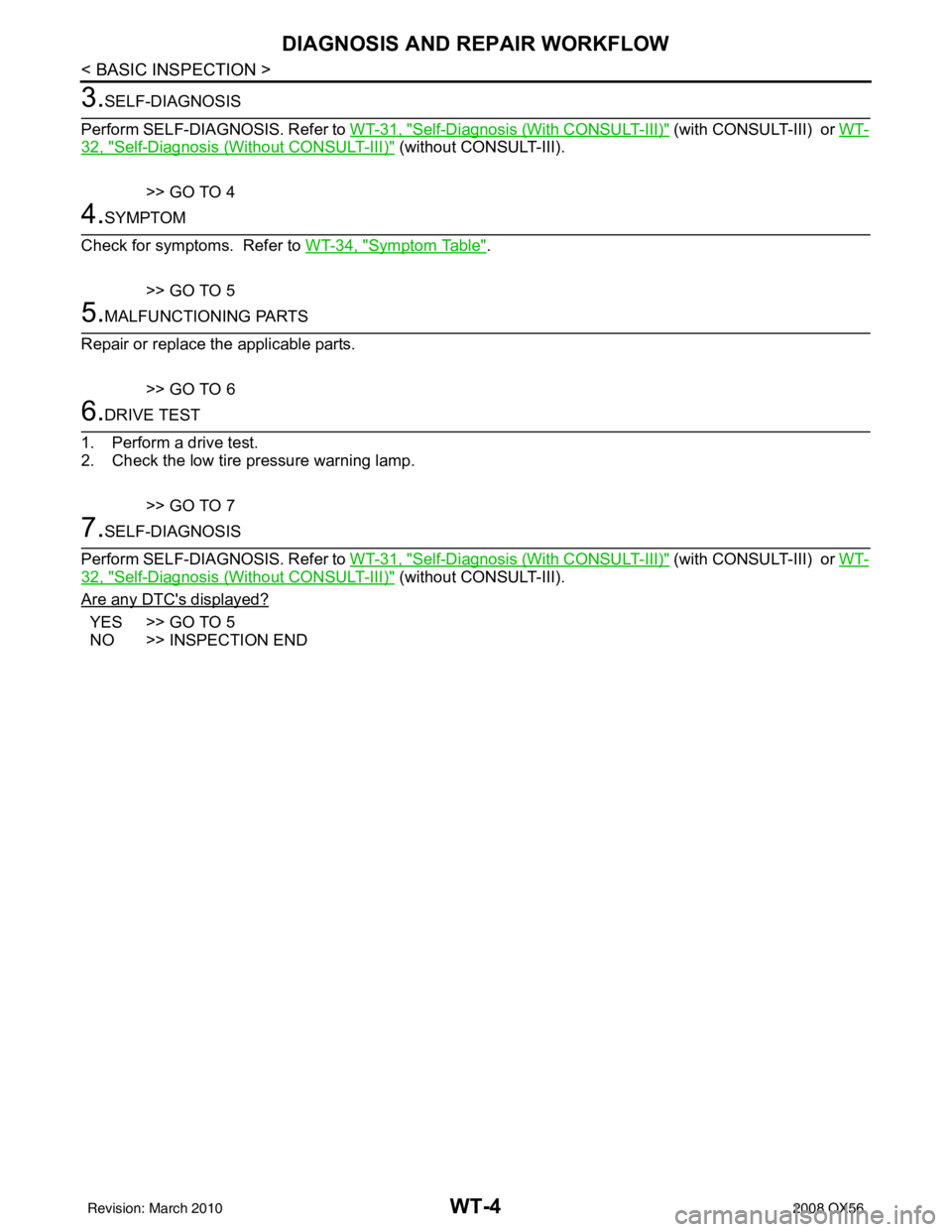
WT-4
< BASIC INSPECTION >
DIAGNOSIS AND REPAIR WORKFLOW
3.SELF-DIAGNOSIS
Perform SELF-DIAGNOSIS. Refer to WT-31, "
Self-Diagnosis (With CONSULT-III)" (with CONSULT-III) or WT-
32, "Self-Diagnosis (Without CONSULT-III)" (without CONSULT-III).
>> GO TO 4
4.SYMPTOM
Check for symptoms. Refer to WT-34, "
Symptom Table".
>> GO TO 5
5.MALFUNCTIONING PARTS
Repair or replace the applicable parts.
>> GO TO 6
6.DRIVE TEST
1. Perform a drive test.
2. Check the low tire pressure warning lamp.
>> GO TO 7
7.SELF-DIAGNOSIS
Perform SELF-DIAGNOSIS. Refer to WT-31, "
Self-Diagnosis (With CONSULT-III)" (with CONSULT-III) or WT-
32, "Self-Diagnosis (Without CONSULT-III)" (without CONSULT-III).
Are any DTC's displayed?
YES >> GO TO 5
NO >> INSPECTION END
Revision: March 2010 2008 QX56
Page 3951 of 4083
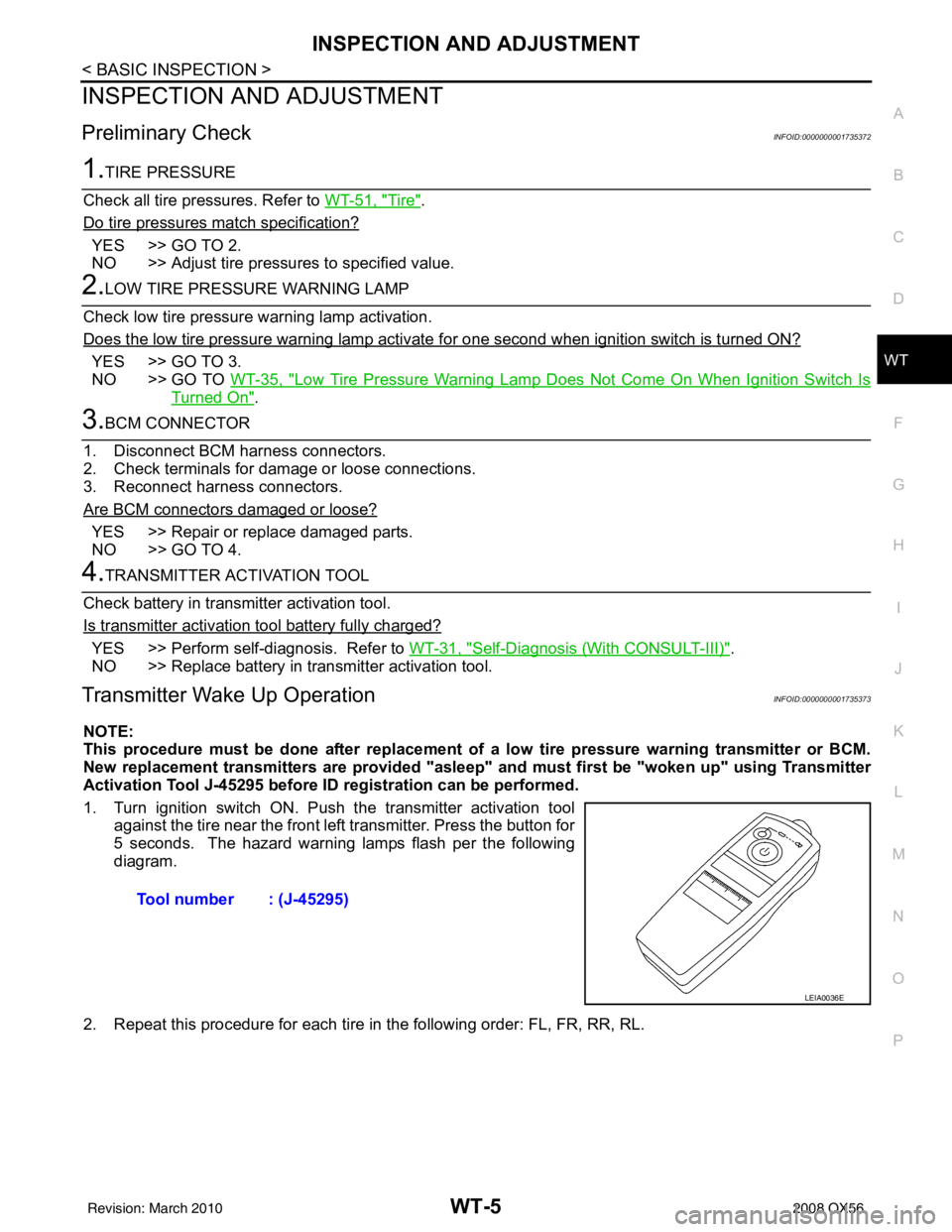
INSPECTION AND ADJUSTMENTWT-5
< BASIC INSPECTION >
C
DF
G H
I
J
K L
M A
B
WT
N
O P
INSPECTION AND ADJUSTMENT
Preliminary CheckINFOID:0000000001735372
1.TIRE PRESSURE
Check all tire pressures. Refer to WT-51, "
Tire".
Do tire pressures match specification?
YES >> GO TO 2.
NO >> Adjust tire pressures to specified value.
2.LOW TIRE PRESSURE WARNING LAMP
Check low tire pressure warning lamp activation.
Does the low tire pressure warning lamp activate for one second when ignition switch is turned ON?
YES >> GO TO 3.
NO >> GO TO WT-35, "
Low Tire Pressure Warning Lamp Does Not Come On When Ignition Switch Is
Turned On".
3.BCM CONNECTOR
1. Disconnect BCM harness connectors.
2. Check terminals for damage or loose connections.
3. Reconnect harness connectors.
Are BCM connectors damaged or loose?
YES >> Repair or replace damaged parts.
NO >> GO TO 4.
4.TRANSMITTER ACTIVATION TOOL
Check battery in transmitter activation tool.
Is transmitter activation tool battery fully charged?
YES >> Perform self-diagnosis. Refer to WT-31, "Self-Diagnosis (With CONSULT-III)".
NO >> Replace battery in transmitter activation tool.
Transmitter Wake Up OperationINFOID:0000000001735373
NOTE:
This procedure must be done after replacement of a low tire pressure warning transmitter or BCM.
New replacement transmitters are provided "asleep" and must first be "woken up" using Transmitter
Activation Tool J-45295 before ID registration can be performed.
1. Turn ignition switch ON. Push the transmitter activation tool against the tire near the front left transmitter. Press the button for
5 seconds. The hazard warning lamps flash per the following
diagram.
2. Repeat this procedure for each tire in the following order: FL, FR, RR, RL. Tool number : (J-45295)
LEIA0036E
Revision: March 2010
2008 QX56
Page 3952 of 4083
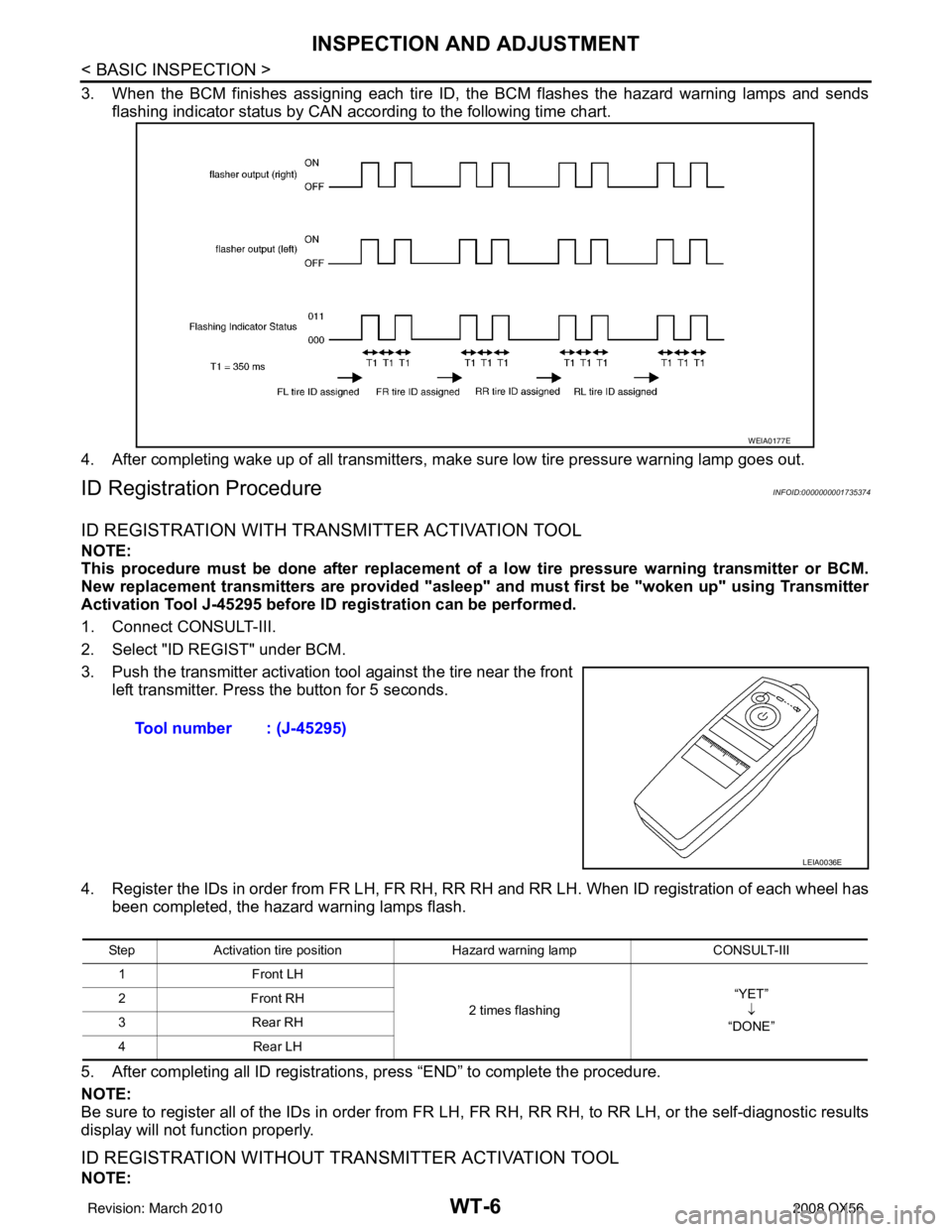
WT-6
< BASIC INSPECTION >
INSPECTION AND ADJUSTMENT
3. When the BCM finishes assigning each tire ID, the BCM flashes the hazard warning lamps and sendsflashing indicator status by CAN according to the following time chart.
4. After completing wake up of all transmitters, make sure low tire pressure warning lamp goes out.
ID Registration ProcedureINFOID:0000000001735374
ID REGISTRATION WITH TRANSMITTER ACTIVATION TOOL
NOTE:
This procedure must be done after replacement of a low tire pressure warning transmitter or BCM.
New replacement transmitters are provided "asleep" and must first be "woken up" using Transmitter
Activation Tool J-45295 before ID registration can be performed.
1. Connect CONSULT-III.
2. Select "ID REGIST" under BCM.
3. Push the transmitter activation tool against the tire near the front left transmitter. Press the button for 5 seconds.
4. Register the IDs in order from FR LH, FR RH, RR RH and RR LH. When ID registration of each wheel has been completed, the hazard warning lamps flash.
5. After completing all ID registrations, press “END” to complete the procedure.
NOTE:
Be sure to register all of the IDs in order from FR LH, FR RH, RR RH, to RR LH, or the self-diagnostic results
display will not function properly.
ID REGISTRATION WITHOUT TRANSMITTER ACTIVATION TOOL
NOTE:
WEIA0177E
Tool number : (J-45295)
LEIA0036E
Step Activation tire position Hazard warning lamp CONSULT-III
1 Front LH
2 times flashing “YET”
↓
“DONE”
2F
ro n t R H
3R ear R H
4 Rear LH
Revision: March 2010 2008 QX56
Page 3953 of 4083
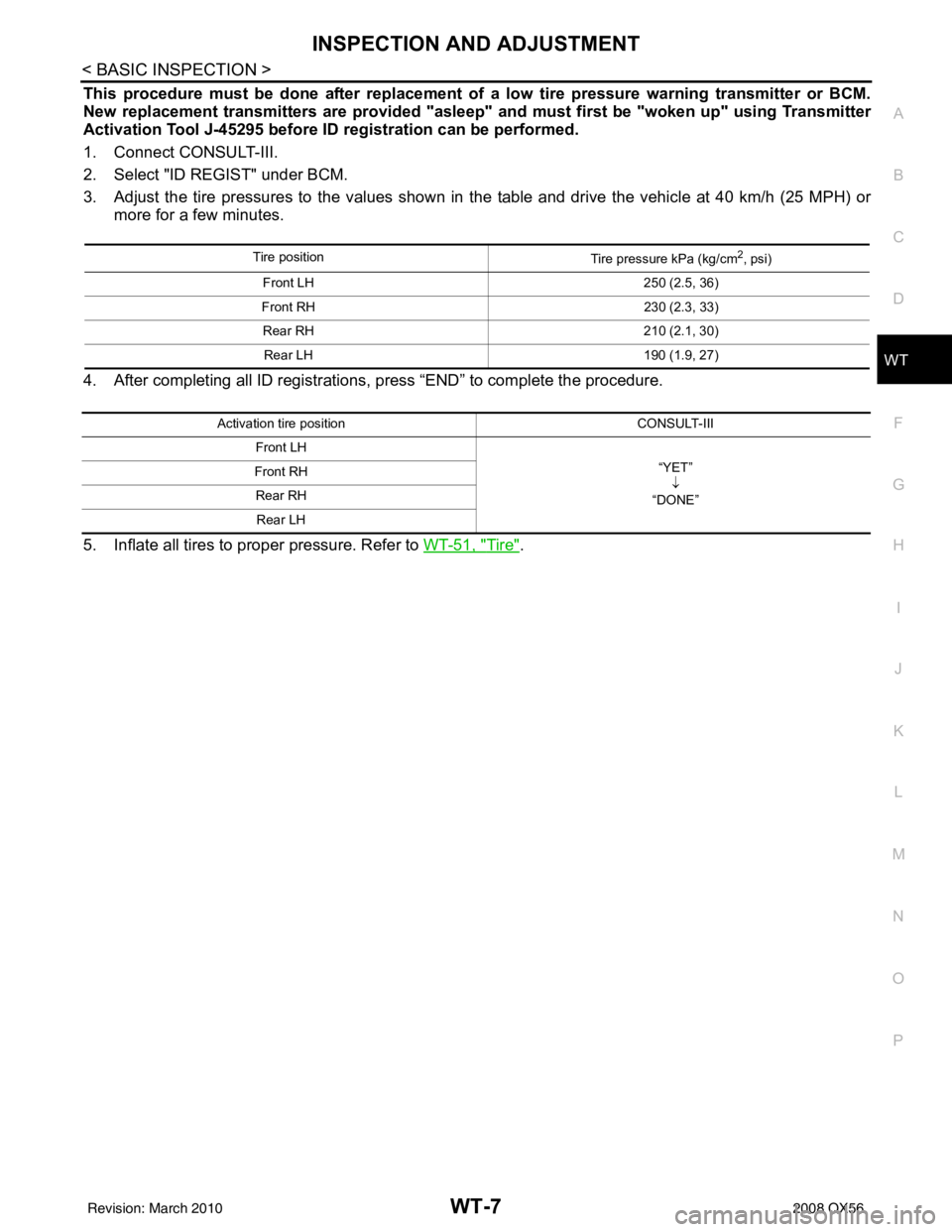
INSPECTION AND ADJUSTMENTWT-7
< BASIC INSPECTION >
C
DF
G H
I
J
K L
M A
B
WT
N
O P
This procedure must be done after replacement of a low tire pressure warning transmitter or BCM.
New replacement transmitters are provided "asleep" and must first be "woken up" using Transmitter
Activation Tool J-45295 before ID registration can be performed.
1. Connect CONSULT-III.
2. Select "ID REGIST" under BCM.
3. Adjust the tire pressures to the values shown in the table and drive the vehicle at 40 km/h (25 MPH) or
more for a few minutes.
4. After completing all ID registrations, press “END” to complete the procedure.
5. Inflate all tires to proper pressure. Refer to WT-51, "
Tire".
Tire position
Tire pressure kPa (kg/cm2, psi)
Front LH 250 (2.5, 36)
Front RH 230 (2.3, 33)
Rear RH 210 (2.1, 30)
Rear LH 190 (1.9, 27)
Activation tire position CONSULT-III
Front LH “YET”↓
“DONE”
Front RH
Rear RHRear LH
Revision: March 2010 2008 QX56